Mary Anne Yarde's Blog: The Coffee Pot Book Club , page 118
October 18, 2019
#BookReview — A Newfound Land (The Graham Saga, Book 4) by Anna Belfrage #timetravel #HistoricalFiction @abelfrageauthor
 A Newfound Land(The Graham Saga, Book 4)By Anna Belfrage
A Newfound Land(The Graham Saga, Book 4)By Anna Belfrage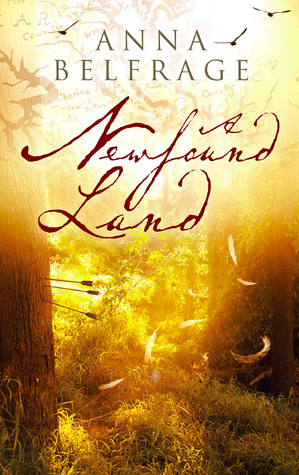
It’s 1672, and Matthew Graham and his family have left Scotland. Having taken the drastic decision to leave their homeland due to religious conflicts, Alexandra and Matthew hope for a simpler, if harsher, life in the wilds of the Colony of Maryland.
Unfortunately, things don’t always turn out as you want them to, and the past has a nasty tendency to resurface at the most inappropriate moments. Both Matthew and Alex are forced to cope with the unexpected reappearance of people they had never thought to meet again, and the screw is turned that much tighter when the four rogue Burley brothers enter their lives.
Matters are further complicated by the strained relations between colonists and the Susquehannock Indians. When Matthew intercedes to stop the Burleys from abducting Indian women into slavery he makes lifelong – and deadly – enemies of them all.
Once again Alex is plunged into an existence where death seems to threaten her man wherever he goes.
Will Matthew see himself – and his family – safe in these new circumstances? And will the past finally be laid to rest?

"I sit here at times and remember the life that was. Before..." His low voice cut through the silence."Before we came," she filled in...
Scotland was no longer Matthew Graham's home. Forced to flee because of a wave of unparalleled persecution, Matthew has sailed with his family across the Atlantic Ocean, hoping for a new life with new opportunities in the Colony of Maryland.
But this is a harsh land, a wild one. It is nothing like Scotland. However, Matthew and his wife, Alex, are determined to prosper. And although life is vastly different from the one they left behind, at least here they are safe from religious persecution. Although that is not true for everyone. The land that they farm once belonged to the Susquehannock people, and although Matthew and Alex have good relations with the Indians, others do not.
To make matters worse, ghosts from both Matthew's and Alex's past threaten to destroy the new life that they have worked so hard to create. And with a war with the Indians becoming more and more probable, it seems that only time will tell who will be the losers and who will write the history...
Anna Belfrage continues to surprise me. When I don't think her writing can get any better, Belfrage pulls another mesmerising story out of the hat. A Newfound Land (The Graham Saga, Book 4) is another enthralling story in The Graham Saga series.
I love these characters so much, and once again, Alex and Matthew find themselves in the thick of things. They try so desperately to get on with their lives and live it peacefully, but life keeps getting in the way. Old enemies threaten their lives and their sense of security. Matthew is drawn into a war which he doesn't agree with. And Alex, well... She wants to live her life surrounded by her children and the man she loves, but Alex is no push-over, and she will stand her ground if anyone threatens what is hers, and she does not care who it is, be it a vile slave trader or a conceited minister. If they dare to cross her, then she will give them a piece of her mind!
We are reintroduced to Magnus in this book. Magnus is Alex's father and comes from the modern-day. He is a very ill man and has not long to live, and he wants to see Alex one more time before he dies. Magnus' reunion with Alex is very bittersweet and very emotional. I adored Magnus, more so in this book than the others. Like Alex, Magnus is a product of his times, and he is not adverse to speaking his mind. However, he is like a fish out of water, and he knows it. The 17th century is so vastly different compared to his time. He initially views his daughter's marriage as one being subservient. He cannot understand why Alex would want to stay in a time where women were considered less than a man and had no say in anything. I thought Magnus' take on the 17th century was very telling, and although the idea that travelling back in time has become romanticised in recent fiction, Belfrage shows that actually, it isn't an era that screams romance. Yes, The Graham Saga is above all things a love story, but it is also brutally realistic in its depiction of the 17th century. Magnus has forsaken modern medicine, modern conveniences for a world that is alien to him. I thought his portrayal was fabulous.
A Newfound Land explores what life was like for not only the colonists but also the indigenous people whose lives were so brutally destroyed by those who promised treaties of peace but delivered disease, devastation and death. I thought Belfrage's portrayal of the Susquehannock tribe was fabulous. Belfrage has described their insufferable plight with sensitivity and care, and although their story is a secondary plot, I thought it was masterfully portrayed.
There are several terrible antagonists in this tale, one of which we met in Book 2, and I had hoped never to meet again. Dominic Jones is as vile in this book as he was in Like Chaff in the Wind (The Graham Saga Book 2). His hatred for Matthew is born of fear, for Matthew knows the truth of his character. Jones is a worthy adversary to put against Matthew. Matthew is no saint, but he isn't intentionally cruel, whereas Jones is. Jones pretends to be a man of standing and wealth, but underneath it all, he is just a brutal murderer and desperate man who cares nothing for anyone but himself.
Having read the first four books in The Graham Saga, it is very clear that this series is staggeringly ambitious in the telling. To keep such momentum going can only be achieved by a writer who not only documents the recorded history with scrupulous care but one who can give fictional characters a sense of realism. Belfrage is that writer. I haven't enjoyed a time-slip book so much since Diana Gabaldon's fabulous Outlander series.
A Newfound Land (The Graham Saga, Book 4) stands very firmly on its own feet. So if you so desired, you can jump right in at Book 4 and not feel lost as to what was going on. However, I recommend you start with Book 1 just because it is brilliant!
I Highly Recommend.
Review by Mary Anne Yarde.The Coffee Pot Book Club.
Pick up your copy ofA Newfound LandAmazon UK • Amazon US
Anna Belfrage
 Had Anna been allowed to choose, she’d have become a time-traveller. As this was impossible, she became a financial professional with two absorbing interests: history and writing. Anna has authored the acclaimed time travelling series The Graham Saga, set in 17th century Scotland and Maryland, as well as the equally acclaimed medieval series The King’s Greatest Enemy which is set in 14th century England. She has recently released the first in a new series, The Wanderer. This time, she steps out of her normal historical context and A Torch in His Heart is with a fast-paced contemporary romantic suspense with paranormal and time-slip ingredients.
Had Anna been allowed to choose, she’d have become a time-traveller. As this was impossible, she became a financial professional with two absorbing interests: history and writing. Anna has authored the acclaimed time travelling series The Graham Saga, set in 17th century Scotland and Maryland, as well as the equally acclaimed medieval series The King’s Greatest Enemy which is set in 14th century England. She has recently released the first in a new series, The Wanderer. This time, she steps out of her normal historical context and A Torch in His Heart is with a fast-paced contemporary romantic suspense with paranormal and time-slip ingredients.Find out more about Anna by visiting her website, or herAmazon page.
Published on October 18, 2019 19:30
October 17, 2019
Let’s talk about Book Titles and Covers with Ann Griffin #amwriting #ampublishing @anngborn2write
Let’s talk about Book Titles
and Covers
with Ann Griffin

What persuades youto purchase a book, when browsing online or at your local bookstore? Market research tells us that familiarity with the author is the single biggest factor in book sales. But let’s say you’re in the mood to experiment with a new author. I’m betting you look for an attractive cover, a catchy title, and a blurb on the back page that tweaks your interest.Let’s also suppose you are an aspiring writer putting in long hours on that baby of yours, your manuscript. You’ve had a title for ages but have given it no thought recently. As for a cover design, it’s the furthest thing from your mind, absorbed as you are in editing, rewriting, and creating a killer ending. Time to pay attention to these very important tasks. In this post, I’ll offer some tips and guidelines for creating a fabulous title and cover. Blurbs I will leave for a future post.

Titles
I went through five different titles before I settled on the one I used for my debut novel, Another Ocean to Cross.At first, I winged it. Whatever came into my head. Not a bad way to start, but then I learned there are guidelines that offer a more systematic approach.· Keep it short. Nix on the ten word titles. Best to keep it under five words and three is better, unless you are J.K. Rowling. On the other hand, one-word titles run the risk of being used in many other books, which could confuse readers.· Keep it interesting. Don’t turn readers away because the title sounds like a 5th grade reader, or a college textbook. Make sure your title says something real about the book. For example, Living with ALS would grab the attention of anyone dealing with that disease, but Living with Sharon says nothing at all.· Research your proposed title. One easy way is to do a search for it on Amazon or Goodreads, because if your title is already in use, or too similar to others, it is best to choose another.· Make it relevantto your book, but with a hint of more to come. (Before We Were Yours, An American Marriage, A Hillbilly Elegy.)· Make it unique. Best seller examples: Little Fires Everywhere, The Price of Time.· Consider the perspective of your main character or antagonist, be they trailblazer, rebel, seductress, tycoon. Think of a two- or three-word phrase that determines how she or he thinks of him/herself. A great example that uses the antagonist’s perspective is The Lord of the Rings.· Alliteration can work. Think Gone Girl, or Pride and Prejudice.· Beware of trends. For several years now, books with “girl” in the title have been everywhere. Besides Gone Girl, we have seen The Girl on the Train, The Girl with the Dragon Tattoo, and many more. A search on Amazon today yielded over 40,000 titles in adult fiction containing the word “girl,” published in the last ninety days alone! If a trend is still hot, you may be able to capitalize on it, but if not, avoid it.· Juxtapose two opposites to create an intriguing title: All the Light We Cannot See, All the Ugly and Wonderful Things.· Add a what, a who, or a where to give your title some context: Where the Crawdads Sing, Under a Scarlet Sky, The Ragged Edge of Night· Simplicity Rules: What about punctuation marks in your title? URLs for your book’s website may not allow all punctuation marks or what they term “unusual characters.” Perhaps your book is set in a foreign land and you wish to use a word or phrase from that language in your title. A hint: if readers can’t pronounce it and don’t know what it means, they are unlikely to buy it.· Think about your cover design with the title:You will likely plan the cover design after you have a title. Make sure they go together, and that one enhances the other. Both should set the tone for the book, whether funny, serious, scary, or romantic.Give yourself permission to play with as many of these suggestions to come up with as long a list of possible titles as you can. Enlist the help of friends: fellow writers, beta readers, book club members. Use social media if you like. I test-ran some of my early titles on social media, asking people if the title would persuade them to pick up the book and look at it. That’s your goal, remember.A Word about SubtitlesNot every book needs a subtitle, but if you feel you absolutely must say a bit more about your book than the main title, create a subtitle. Don’t add a subtitle simply because you want to have a long title and I told you not to. To add more context, a subtitle can be useful. For example, the title Philipovna written by a friend of mine, Valentina Gal, tells us that the book is about a woman probably from Ukraine or Russia, but nothing more. Her subtitle, Daughter of Sorrow, lets us know there is a sad story inside. Another useful subtitle example: The Fire Line by Fernanda Santos. Her subtitle tells us all: The Story of the Granite Mountain Hotshots and One of the Deadliest Days in American Firefighting.By the time you work through these suggestions, you should have a list of three or four potential titles. Time to pick the one you love best and won’t get tired of.
Book Covers
The subject of book covers is lengthy. This is not an exhaustive treatise, merely an introduction and some guidelines for writers new to publishing.Modern covers, together with the title, have one goal: to persuade the reader to pick up the book and look inside. What the reader does next depends on the blurb on the back, and the contents of the book.If you are an independently published author, you must handle this yourself. Notice, I did not say DO it all yourself. Unless you are a graphic artist, I strongly recommend that you hire a designer. Prices can range from less than a hundred dollars to thousands. You know your budget, so stick to it.Before you hire a designer, you should have an idea of what you want. The cover should reflect the content of the book, or one vital detail in the book. It should be aesthetically pleasing, in attractive colors, and suitable to the subject.Go to the nearest bookstore, or simply log onto Amazon and browse through the books in your genre. Each genre tends to have must-haves in their covers. Notice what covers you like, which you don’t like, and why. As you answer these questions for yourself, you will begin to build a mental image of the cover you want.For my historical fiction novel, I wanted a twenty-something woman wearing 40s style clothing, prepared for travel. There are several wartime voyages in the book, so I also wanted a WWII warship in the background. I wanted my female character looking away from the ship, because she has made a difficult decision, and she is not sure it is the right one.My designer was responsive to my needs, and we went through quite a few iterations before I was satisfied. She had the license for the graphics, which is another important consideration. Whatever you do, don’t copy a photo you find on the internet without permission. You could get into serious trouble.There are many companies that design generic book covers. You plunk in your genre and hundreds of potential covers pop up. They’ll add your title and bingo! Your cover is ready. Some of them guarantee you will be the only user, others do not, so shop around if that is the route you decide to go. Here is one example: EbookOrPrint.Sites such as Canva may convince you that you can design your own, with a little help.There are also sites like Fiver where multiple graphic designers from all over the world bid for your work. This is the site I used but there are many others. Ask your fellow writers for references and look for reviews of each site you consider.You have your cover, and now it is time to consider font, size, and placement on the cover. Be sure it is easy to read. The font should match the book contents. For example, don’t use a techno font for a romance, and don’t use a beautiful script font for horror.Your designer should have two or three options for you to choose from. Be polite but be honest. This is not a time to settle.Sharing potential covers on social media and asking which your followers prefer is a great way to not only get feedback, but to build interest in your coming book.If a few published authors you know are willing to look over your cover, you may gain some very useful observations. One viewer of my cover, unfortunately after I had published, noticed that the title could have been placed higher on the page, which would have made it more legible against the character’s similarly-colored clothing. Such a tiny detail, and people like my cover, but it could have been that little bit better.The finish of your cover can be matte or glossy. If you’re willing to pay a more, you can add linen finishes, gold lettering, and other bells and whistles. It is a personal decision, but again, that trip to the bookstore to see what the trad published books look like can be instructive. Above all, you want your cover to look professional.If you have won an award and are eligible to put a sticker on your book, adding it to the cover design assures you will never have to pay separately for stickers again. Multiple awards? Congratulations! But one sticker per book is all you need. Choose the most impressive award or the sticker you like best. Brag about the others on your website.If you are publishing an e-book only, you simply need a front cover. The paperback requires design of the spine and the back cover.The spine should have the title, your name, and the publisher imprint (logo), if any. The cover designer will do this for you.There are plenty of companies who will help you to create a logo if you want one. Some are free. That sounds appealing, but it can be difficult to get what you really want. For a small fee, companies will offer their created logos that you adapt to your own business name. You may find exactly what you want from one of these companies. Obviously, the more help a
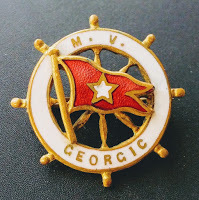 company gives you, the more they will charge.
company gives you, the more they will charge.
 My business name is Georgic Publishing LLC and here is the logo I came up with. The Georgic is a real ship mentioned in my book, so I chose a ship’s wheel for my logo, based on a brooch I own from the ship. Fancy? No, but it serves the purpose for me at this point in my journey.You may choose to wrap the image of the front cover onto the spine, even straight across the back cover, but it is not necessary to do so. Depending on how busy your cover is, it may distract from the key information in your blurb.The back cover is your advertising space. As promised, I’m not going to get into blurbs in this post, except to say that you must have one. The blurb should take up half to two thirds of your back cover. The rest should be your short author bio, and, if space permits, a headshot of you. I recommend working on your blurb and your bio while you’re editing your manuscript.
My business name is Georgic Publishing LLC and here is the logo I came up with. The Georgic is a real ship mentioned in my book, so I chose a ship’s wheel for my logo, based on a brooch I own from the ship. Fancy? No, but it serves the purpose for me at this point in my journey.You may choose to wrap the image of the front cover onto the spine, even straight across the back cover, but it is not necessary to do so. Depending on how busy your cover is, it may distract from the key information in your blurb.The back cover is your advertising space. As promised, I’m not going to get into blurbs in this post, except to say that you must have one. The blurb should take up half to two thirds of your back cover. The rest should be your short author bio, and, if space permits, a headshot of you. I recommend working on your blurb and your bio while you’re editing your manuscript.
I hope my suggestions help you along the road to publication. Thank you for reading, and I welcome questions, comments, and feedback.Ann Griffin, Author
Another Ocean to CrossBy Ann Griffin

2018 B.R.A.G. Medallion Honoree and FINALIST - Wishing Tree Book Awards
Germany, 1938: Talented Jewish teen artist and secret activist, Renata Lowenthal, convinces her reluctant parents that they must leave, before conditions for Jews worsen. Her father, Karl, a doctor no longer allowed to practice, and Lea, her mother, depressed over the loss of a child years before, decide to head to Palestine. After a hazardous journey, they find themselves in Egypt. Using her ingenuity and artistic talent, Renata gets her parents into Alexandria, the headquarters of the Royal Navy’s Mediterranean Fleet. But war’s tentacles reach to Egypt, and the family is still in danger, with nowhere to go. Renata looks to the Allied sailors and soldiers, thinking a husband may provide an opportunity to move out of harm’s way. After a steamy courtship, she marries Ray Stern, a Canadian, shortly before he is deployed to war service. Not long after the birth of their child, Renata is faced with an agonizing decision that will have repercussions many years into the future. Determined to keep her family together, she must dig into the depths of her being, to find a resourcefulness and courage she never knew she had, to save her marriage and her family.
Pick up your copy of
Another Ocean to Cross
Amazon UK • Amazon US
Ann Griffin
 Ann Griffin comes from a family of adventurous women. An immigrant twice (to Canada and to the USA,) she understands from personal experience the challenges of being uprooted, either by choice or not, and remaking a life in a new country.Ann writes historical fiction, flash fiction, and short non-fiction. She has published articles in the journal of the British Home Child Advocacy and Research Association, and guest blogged for the award-winning writers’ blog, Writers in the Storm.She enjoys choral music, golf, and her miniature poodle, Simber. Ann and her husband divide their time between Mesa, Arizona and Toronto, Canada.Connect with Ann: Website • Facebook • Twitter.Georgic Publishing LLC 2018
Ann Griffin comes from a family of adventurous women. An immigrant twice (to Canada and to the USA,) she understands from personal experience the challenges of being uprooted, either by choice or not, and remaking a life in a new country.Ann writes historical fiction, flash fiction, and short non-fiction. She has published articles in the journal of the British Home Child Advocacy and Research Association, and guest blogged for the award-winning writers’ blog, Writers in the Storm.She enjoys choral music, golf, and her miniature poodle, Simber. Ann and her husband divide their time between Mesa, Arizona and Toronto, Canada.Connect with Ann: Website • Facebook • Twitter.Georgic Publishing LLC 2018
Published on October 17, 2019 20:00
October 16, 2019
Now is your chance to vote for your favourite book cover for OCTOBER over on The Coffee Pot Book Club! #BookCovers #CoffeePotBookClub #Competition
The Coffee Pot Book Club
Promoting Historical Fiction since 2015
Book Cover of the Month

Readers' Choice! October 2019
Now is your chance to vote for your favourite book cover for June. All you need to do is pop the number of the book cover you like along with the book title in the comment section at the bottom of the page.
The winner will be announced on the 25th October.
★ 1 ★
Katherine - Tudor Duchess
By Tony Riches

★ 2 ★
The Queen of Warriors
By Zenobia Neil

★ 3 ★
A King Under Siege
By Mercedes Rochelle

★ 4 ★
A Place in the World
By Amy Maroney

★ 5 ★
The Last of the Romans
By Derek Birks

★ 6 ★
The WhirligigBy Richard Buxton

★ 7 ★Dragon LadyBy Autumn Bardot

★ 8 ★The Castilian HawkBy Anna Belfrage

★ 9 ★The Viscount's PetBy Kryssie Fortune

★ 10 ★Farewell My LifeBy Cynthia Sally Haggard

★ 11 ★A Phoenix RisingBy Vivienne Brereton

★ 12 ★Citizen ArmiesBy Beryl Kingston
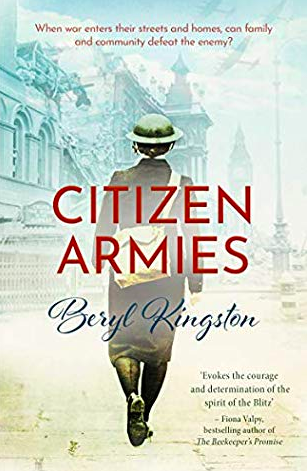
★ 13 ★The Lost Seed of the PomegranateBy Gillie Bowen
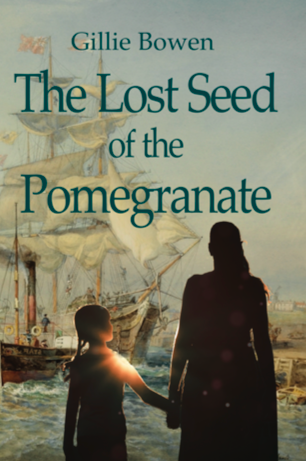
★ 14 ★Love Lost In TimeBy Cathie Dunn

★ 15 ★Nav'Aria: The Pyre of TarsinBy K.J. Backer

★ 16 ★The Lady of the TowerBy Elizabeth St.John

★ 17 ★Falling for WolfeBy Dawn Marie Clifton

★ 18 ★Another Ocean to CrossBy Ann Griffin

★ 19 ★Wanders Far By David Fitz-Gerald

★ 20 ★Relic SeekerBy Fiona Tarr

★ 21 ★The Smuggler's EscapeBy Barbara Monajem

★ 22 ★The Walls of LuccaBy Steve Physioc

★ 23 ★The Highlander's Defiant CaptiveBy Anna Campbell

★ 24 ★Antonius: Second in CommandBy Brook Allen

★ 25 ★Cousins of Anarchy:Stephen and Matilda's Civil WarBy Matthew Lewis

★ 26 ★The Hosting Of The SidheBy J.P. Reedman

★ 27 ★Concordia: The Briton and the DaneBy Mary Ann Bernal

Good Luck!
Published on October 16, 2019 09:05
October 15, 2019
Join me in conversation with #HistoricalFiction author, Emma Lombard #amwriting @LombardEmma
A Conversation with Historical Fiction author, Emma Lombard.
Please give a warm Coffee Pot welcome to author, Emma Lombard. Emma, before we begin could you tell my readers a little about yourself?
I am an Australian author living in sunny Brisbane. I was born in the UK and I called Zimbabwe and South Africa home for a few years before moving to Australia in 2000.
Before I started writing historical fiction, I was and still am a master goat wrangler—in other words: a mother to four teenage sons! In my past life, I was a freelance editor in the corporate world and lent my editing prowess to various industries including aviation, aquatic ecology, education and the world of academia. But now, I am a full-time writer.
I am an active member of Twitter’s #WritingCommunity where I love welcoming new writers to social media and helping them find their voices. It is what inspired my blog series Twitter Tips For Newbies.
To combat my chronic fear of heights, I climbed the Eiffel Tower TWICE! Gulp!

What inspired you to write DISCERNING GRACE?
I’ve always been a little nosy—I know, I know … curiosity killed the cat! But back in 2001 during one of my regular letter-writing sessions to my grandmother in England, I decided I’d like to know a little more about our family history from the older generation. Once they’ve passed it’s so hard to find out what kinds of people they knew and the sorts of things they got up to.
So, my darling late grandmother, who I was incredibly close to, indulgently began answering my questions and documenting memories of her own childhood and stories of ancestors. All it took was for me to read the opening to one of her letters and I just KNEW I had to write a story about it! This is what the letter said, ‘Your GGG grandmother was only 16 when she ran away from home to marry a sea captain … her family cut her off and she sailed the seas with him …’
Come on! What author couldn’t resist a little bit of real-life inspiration like that?
And so, that is how my purely fictional, historical naval adventure— with a dash of romance—blossomed. I’ve been thrilled by the journey of writing it and all the research too, but most of all, I’ve loved imagining the incredible courage and fortitude it would have taken my ancestor to choose such a life! Plus, there is my GGG grandfather’s side of the tale to consider too. As my grandmother put it, they were ‘obviously a very enlightened couple, and she a very, very liberated woman.’

What a wonderful story. What were the challenges you faced in researching this period of history?
There is so much in the history books about men at sea but comparatively little about women. Certainly, history shows us that women went to sea, whether with permission or not— as passengers or wives, but there are fewer records of what life was like at sea for these women.
Thankfully, I found some incredible resources in Seafaring Women by renowned historian, Linda Grant De Pauw, Female Tars by Suzanne J. Stark as well as Hen Frigates and She Captains by maritime historian, Joan Durett. They are a treasure trove of an insight into the lives of many women at sea, drawn from newspaper articles, diaries and historical records. The personalised accounts from the women’s diaries gives so much more depth and emotion, outlining their hopes and fears as well as lamenting the loss of luxuries and comfort, than say a ship’s books recorded by a male clerk, which while brimming with factual information, is devoid of that personal touch.
Armed with the knowledge my grandmother gave me of my GGG grandmother’s character, plus this wealth of insight into other women’s life at sea, I had a great foundation upon which to build my fictional tale.As a historical writer, you want to ensure you get all the facts straight but sometimes there comes a point in your story where creative licence kicks in and certain events have to go a certain way to keep your readers engaged and entertained. Some historical authors stick strictly to the facts, and kudos to them because this requires an extraordinary amount of research! But I have enjoyed bending the rules a little here and there to keep my story flowing.
While most Royal Navy captains commanded their ships under the governance of the Articles of War, there are plenty of tales of wayward captains who either abused the punishments or were indifferent to complying with the regulations. Let’s face it, once out on the open ocean for years at a time, a ship was the captain’s kingdom to command as he pleased. My research gave me a flavour of the dress, etiquette, food and expectations of shipboard life, which helped me thread this authenticity into my works.Any doubt I had about my characters being too modern and breaching the class or gender expectations of the time was securely put to bed by Elizabeth Gaskell’s series North and South. Here is a female author who published her works in 1854 with a recurring theme of complex social conflicts, including an entitled female protagonist who befriends working-class characters. As can be expected, Gaskell’s work received scathing critical reception for going against the prevailing views of the time but it is a great source for me, as a modern author, to know that these thoughts existed back then and has enabled me to confidently craft some unconventional relationships between my characters.
Here’s an incredible blog post by historical editor, Andrew Noakes, who gathered the Top Tips on Writing Historical Fiction From 64 Successful Historical Novelists.

Can you tell us three things that set your novel apart?
My research highlighted just how few naval adventures are authored by women andhave a female protagonist. Some are written by women but have male protagonists—Agnes Strickland’s The Shipwreck; and some are written by men with a female protagonist —Douglas Kelley’s The Captain’s Wife. There are of course the fabulous works of Linda Collison (Patricia McPherson Nautical Adventures) and Beth Powning (The Sea Captain’s Wife), to name a couple. My being a female author of a nautical adventure with a female protagonist is quite a happy coincidence, and it certainly was not a deciding factor when I set out writing this genre.
My novel is very loosely based on a true story. I deliberately did not delve too far into my ancestor’s personal history. I felt it was an intrusion enough that I was already borrowing the premise of their incredible story, which was simply a juicy starting point for my purely fictional creation.
I have created a naval adventure that will appeal to a wider audience as it is not overly bogged down with the technicalities of sailing or navigation found in a lot of naval fiction. It instead focuses more on the dynamics of relationships between rank and class, and on breaking down social and gender stereotypes of the day. Many changes in history come about as a result of pioneering individuals and I hope to have captured this spirit in my characters. And let’s not forget, it’s also a rollicking adventure!

Thank you so much for taking the time to talk to us today. One last question… Can you tell us what are you currently working on?
I always intended to write a series of books because that is what I love reading. I adore the continuation of a set of characters as their lives move into different stages. I already have the drafts of the next couple of books written but as every historical writer knows, an author’s job is never done, so it’s back to the grindstone to tighten the second book while the first is in the querying trenches.
Discerning Grace
By Emma Lombard
London 1826. Debutante, Grace Baxter, will notmarry old Lord Silverton with his salivary incontinence and dead-mouse stink.She is devastated to discover she is a pawn in a business arrangement between slobbery Silverton and her calculating parents.Refusing this fate, Grace resolves to stow away. Heading to the docks, disguised as a lad to ease her escape, Grace encounters smooth-talking naval recruiter, Gilly, who lures her aboard HMS Discerning with promises of freedom and exploration in South America.
When Grace’s big mouth lands her bare-bottomed over a cannon for insubordination, her identity is exposed. The captain wants her back in London but his orders, to chart the icy archipelago of Tierra del Fuego, forbid it. Lieutenant Seamus Fitzwilliam gallantly offers to take Grace off the fretting captain’s hands by placing her under his protection.
Grace must now win over the crew she betrayed with her secret, while managing her feelings towards her taciturn protector, whose obstinate chivalry stifles her new-found independence.
Coming soon…
Giveaway
Emma Lombard is giving away a $20.00 Amazon Gift Card. All you have to do is caption this picture.

Leave your caption in the comment section at the end of this post.
Giveaway Rules
• Leave your answer in the comments at the bottom of this post.
• Giveaway ends at 11:59pm GMT on October 23rd .
You must be 18 or older to enter.
• Giveaway is only open Internationally.
•Only one entry per household.
• All giveaway entrants agree to be honest and not cheat the systems; any suspect of fraud is decided upon by blog/site owner and the sponsor, and entrants may be disqualified at our discretion.
•Winners will be announced in the comments.
• Winner has 48 hours to claim prize or new winner is chosen.
Emma Lombard
As I don’t yet have a release date for my book, readers are welcome to subscribe to my email list to receive information about blog updates, newsletters, interviews, book reviews and book release news!
Or I can be found on Facebook or Twitter.
Interested in meeting my characters? Pop on over to my author website.
Published on October 15, 2019 20:00
October 14, 2019
Why I was foolish enough to not stop at one book in The Lydiard Chronicles by Elizabeth St.John #amwriting #HistoricalFiction @ElizStJohn
Amazon UK • Amazon US
Elizabeth St.John
 Elizabeth St.John was brought up in England and lives in California. To inform her writing, she has tracked down family papers and residences from Nottingham Castle, Lydiard Park, and Castle Fonmon to the Tower of London. Although the family sold a few castles and country homes along the way (it's hard to keep a good castle going these days), Elizabeth's family still occupy them - in the form of portraits, memoirs, and gardens that carry their imprint. And the occasional ghost. But that's a different story...Connect with Elizabeth: Website • Facebook • Twitter.
Elizabeth St.John was brought up in England and lives in California. To inform her writing, she has tracked down family papers and residences from Nottingham Castle, Lydiard Park, and Castle Fonmon to the Tower of London. Although the family sold a few castles and country homes along the way (it's hard to keep a good castle going these days), Elizabeth's family still occupy them - in the form of portraits, memoirs, and gardens that carry their imprint. And the occasional ghost. But that's a different story...Connect with Elizabeth: Website • Facebook • Twitter.
Elizabeth St.John
 Elizabeth St.John was brought up in England and lives in California. To inform her writing, she has tracked down family papers and residences from Nottingham Castle, Lydiard Park, and Castle Fonmon to the Tower of London. Although the family sold a few castles and country homes along the way (it's hard to keep a good castle going these days), Elizabeth's family still occupy them - in the form of portraits, memoirs, and gardens that carry their imprint. And the occasional ghost. But that's a different story...Connect with Elizabeth: Website • Facebook • Twitter.
Elizabeth St.John was brought up in England and lives in California. To inform her writing, she has tracked down family papers and residences from Nottingham Castle, Lydiard Park, and Castle Fonmon to the Tower of London. Although the family sold a few castles and country homes along the way (it's hard to keep a good castle going these days), Elizabeth's family still occupy them - in the form of portraits, memoirs, and gardens that carry their imprint. And the occasional ghost. But that's a different story...Connect with Elizabeth: Website • Facebook • Twitter.
Published on October 14, 2019 20:30
October 13, 2019
Check out K. J. Backer's fabulous new book — Nav’Aria: The Pyre of Tarsin #NewRelease #HistoricalFantasy @KJBacker
Published on October 13, 2019 23:41
Join Historical Fiction author, Cathie Dunn, as she explores what life was like in the time of Charlemagne #History #France @cathiedunn
Life in the time of…Charlemagne!
By Cathie Dunn
I’m delighted to be here today to talk about a time that is often overlooked in historical fiction. The era of Charlemagne – the late 8th / early 9thcentury.

Restored fortifications of Carcassonne, © Cathie Dunn
After the ‘dark ages’ (who says they were ‘dark’?), King Charles of the Franks’ reign saw wide areas of the continent of the European continent conquered. Also known as Pater Europae (Father of Europe), he ruled over a vast area covering much of western and southern Europe. Often, forceful submission was followed by adherence to new laws created by the Franks.
 hrone of Charlemagne, ~790 AD, Wikipedia.
hrone of Charlemagne, ~790 AD, Wikipedia.In the late 770s – the start of my upcoming novel Love Lost in Time – Charlemagne was still ‘only’ king of the Franks, not Roman Emperor, but his vision of expansion was swiftly becoming reality. His conquests were brutal, to the point of cruel (a mass executions of 4,500 ‘rebels’, such as in Saxony in 782, for example), but he also brought peace and the rule of law to many war-torn areas.
However, we’re not at Charlemagne’s palace in Aix-la-Chapelle nor on his campaign trails, but instead we are exploring a hitherto neglected region: Septimania.
Situated along the western Mediterranean and into the Pyrenees, Septimania was an area that had already seen much fighting by the time it was taken over by the Franks in 759. Originally part of the Roman empire as Gallia Narbonnensis, the area stretching from Provence in the east (divided by the Rhône river) to the Garonne river in the south-west, was later held by Visigoth kings. When the Salian Franks began to expand their territory, fighting ensued to retain the fertile region. In 508, the Salians failed to take the fortified site at Carcassonne, and Septimania was henceforth ruled between the Visigoths and Ostrogoths.
 Sarcophagus – Caption: 4th century Visigoth sarcophagus © Cathie Dunn.
Sarcophagus – Caption: 4th century Visigoth sarcophagus © Cathie Dunn.However, over two hundred years later, with the Umayyad Saracens pushing north from the Iberian peninsula, and the Franks pushing southwards, Septimania and neighbouring Vasconia (Gascony) never really stayed calm. By 732, Septimania was part of the Umayyad Empire of Al-Andalus which, for a long time, countered attacks by the Franks into their northern territories.
A wali, ruling out of the city of Narbonne, governed the outlying area. Despite the Saracen occupation, much of Septimania remained under ancient Roman and Gothic law, with Visigoths holding important posts. People were free to practice their own religion, mostly a form of Arian Christianity (a freedom that stopped under the Franks) and life continued almost unchanged.
 Map of Septimania, 537 AD, Wikipedia.
Map of Septimania, 537 AD, Wikipedia.In 759, Charlemagne’s father, Pepin the Short, finally conquered Septimania, and many inhabitants, content with their lot under the Umayyad rulers, fled south into the Pyrenees or to Toledo. Many of the Arian population simply did not want to be ruled or converted by the Catholic Franks.
In such circumstances, myths are created (often much later, as in this case), and one such myth concerns Dame Carcas, a Saracen princess and widow, who, after years of being besieged by Charlemagne at her fortress, had the idea of feeding a pig with a bag of wheat, then throwing it over the battlements. On seeing that the defenders still appeared to have ample provisions, Charlemagne retreated. When the ingenious lady had all bells rung in celebration, the Franks exclaimed: “Carcas sonne!” (Carcas sounds) – thereby creating the fortress’s name. Alas, as inspiring as the tale is, there is no historical evidence of her, or of Charlemagne being at a siege in Carcassonne, which was taken in 759.
 Dame Carcas, Carcassonne, © Adobe Stock.
Dame Carcas, Carcassonne, © Adobe Stock.It is noted that Charlemagne, on recognising the deserted land, began to grant fiefs to Visigoths and descendants of the Romans. At the same time, he appointed fellow Franks to hold strategic seats: Bordeaux and Toulouse were vital in the defence against the ever-rebellious Vasconians in the Pyrenees. Eventually, he established the ‘Spanish marches’ – a defensive buffer line against the caliphate to the south.
He made good use of many of the fortified sites that already existed north of the Pyrenees. Carcassonne was one such, although with the establishment of the march in the mountains, its importance waned a little. At the time of Charlemagne, a Visigoth named Bellon became the first Count of Carcassonne. As we don’t know for certain who appointed him, at a time of many local appointments by Charlemagne, I took the liberty to combine the two events to connect Bellon to Charlemagne. But as a result, Bellon became a Catholic, a fate many shared (often reluctantly) following the annexation of Septimania. He held the fortress in the name of the Franks, an important post for such a (now) little known man of Visigoth origins.
 Restored tower at Carcassonne, © Cathie Dunn.
Restored tower at Carcassonne, © Cathie Dunn.Charlemagne also founded and supported many religious houses in the area, to establish centres of learning and teaching, thereby actively pushing the Catholic agenda. It is not surprising that many Arians either submitted or fled. They found their freedoms much curtailed under the Franks.
Daily life was harsh in a region of long hot summers, bringing droughts, and chilly winters, with winds howling along the plain between the Pyrenees and the outlying areas of what is now the Massif Central. The Romans had begun to grow vines, and the summer sunshine was vital for their growth.
With the Franks arrived Salian law, which Charlemagne reformed, slowly replacing the ancient traditional Roman and Visigoth laws of the land unless they were incorporated.
The area of Septimania and the Pyrenees hold several languages. People in Carcassonne would have likely spoken a Romance language, which later evolved into the Langue d’Oc (the language of Occitania) which is still spoken here today.
A defensive region for many decades, there was no long-lasting peace in Septimania following the arrival of the Franks. The constant threat of warfare still hung over the beautiful hills and plains and would do so for many more centuries.
To this day, the rugged ruins of these ancient fortresses make for fascinating excursions into the distant past, with many dating back to Roman, Visigoth and Carolingian days.
 Carcassonne – the citadel in 2019, © Carcassonne Photography Tours.
Carcassonne – the citadel in 2019, © Carcassonne Photography Tours.Love Lost in TimeBy Cathie Dunn

AD 2018Languedoc, south-west France
Madeleine Winters must live in her late mother’s old stone house in south-west France for one year before she can claim her inheritance – and sell it! Reluctantly leaving her life in England, she begins to renovate the house. But she’s not prepared for all the discoveries…
Is it her imagination when she hears a woman’s voice? Or when the ground shakes?
When ancient human bones belonging to a female are found beneath the kitchen floor, the mystery deepens. How did the woman end up buried, without a sarcophagus and all alone, in that particular spot in the Cabardès hills?
And why were her bones broken?
AD 777Septimania, on the coast of the Mediterranean Sea
17-year-old Nanthild attends Charlemagne’s court with her father, where she is introduced to Bellon of Carcassonne. Unimpressed by the blustering young warrior, Nanthild is shocked when Charlemagne and her father arrange their wedding as a gesture of ensuring Bellon’s support in the king’s conquest of the volatile southern region of Septimania.
Despite his Visigoth origins, Bellon is installed as Count of Carcassonne, and he soon has to face challenges to Frankish rule that often keep him away from home – and his family.
Bellon’s absences make it easy for Nanthild to keep her calling as a healer and wise woman from him, and she continues to visit those in need of her help.
But dangers lurk on her journey…
Pick up your copy ofLove Lost In TimeAmazon
Cathie Dunn
 Cathie writes historical fiction & romance.On and off, she’s been writing for over twenty years. In 2008/09, she took courses online in Creative Writing at Lancaster University, with a focus on novel writing, which she now teaches in south-west France. She loves researching for her stories, delving into history books and visiting castles and historic sites.Cathie is currently working on two novels: the sequel to Dark Deceit; and the first case in the Loup de Foix Mysteries, a series of historical murder mysteries set in the early 13th century around Carcassonne in south-west France. Her books have garnered praise from reviewers and readers for their authentic description of the past.After many years in Scotland, Cathie now lives in south-west France with her husband, two cats and a dog.Connectwith Cathie: Facebook • Facebook Author Page • Twitter • Instagram.
Cathie writes historical fiction & romance.On and off, she’s been writing for over twenty years. In 2008/09, she took courses online in Creative Writing at Lancaster University, with a focus on novel writing, which she now teaches in south-west France. She loves researching for her stories, delving into history books and visiting castles and historic sites.Cathie is currently working on two novels: the sequel to Dark Deceit; and the first case in the Loup de Foix Mysteries, a series of historical murder mysteries set in the early 13th century around Carcassonne in south-west France. Her books have garnered praise from reviewers and readers for their authentic description of the past.After many years in Scotland, Cathie now lives in south-west France with her husband, two cats and a dog.Connectwith Cathie: Facebook • Facebook Author Page • Twitter • Instagram.
Published on October 13, 2019 19:30
October 11, 2019
#BookReview — The Prodigal Son (The Graham Saga, Book #3) by Anna Belfrage #timetravel #HistoricalFiction @abelfrageauthor
 The Prodigal Son(The Graham Saga, Book #3)By Anna Belfrage
The Prodigal Son(The Graham Saga, Book #3)By Anna Belfrage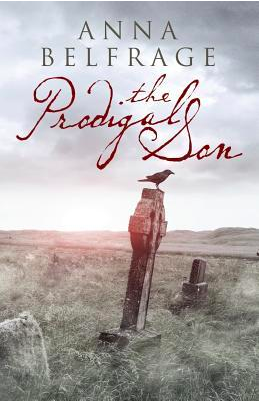
Matthew's continued and stubborn religious support places his entire family in danger, causing quite the strain on his marriage. After all, Alex was born in 1976 and raised in an extremely secular environment (prior to being flung three centuries backwards in time) so she finds all these faith related conflicts very difficult to comprehend.

"Come, come, mistress, all of you know that the king requires all men to swear oaths of fealty to him and his church. A most necessary measure here, where Covenanters stand as thick on the ground as common daisies..."
Matthew Graham feared that if he signed the oath, if he renounced his faith, then he would risk his very soul and a chance at life everlasting, but if he did not, if he continued to aid the likes of Alexander "Sandy" Peden, then he put his wife and his children in mortal danger.
For Alex Graham, it is a simple choice. Family must come first, and if her foolish husband cannot see that then... Things had been so different in her own time. More tolerant. Less intimidation. But Alex had made her choice to stay with Matthew in the 17th Century many years ago, and she does not regret that choice. But, if Matthew continues to play this dangerous game of cat and mouse, then she can foresee only death and despair.
However, the greater the persecution, the stronger the convictions of the Covenanters become. But such religious zeal is a two-edged sword, and while God watches on with apparent disinterest, Matthew risks losing everything and everyone he has ever loved.
Set during a time of religious persecution and civil unrest, The Prodigal Son (The Graham Saga, Book 3) by Anna Belfrage is the unforgettable story of one man's fight to defend his faith against insurmountable odds and one woman's determination to save her husband from himself.
Oh, my. I don't think words can express how much I loved The Prodigal Son. I was already invested in the characters of Matthew and Alex after the first two books, but what I did not expect was to fall in love with them all over again. I was swept totally off my feet by this novel.
Belfrage has written a book that not only evokes the mood of this era, and the hardship and uncertainty, but she has also penned a story about love and loss, heartache and joy. All of which has a sense of realism about it. These characters are profoundly affected by what they see, what they have experienced, and indeed their own decisions. This story, above everything else, explores the human condition — from birth to death, with everything in between, set in a backdrop of violence and repression. At times this book was deeply moving, at other times joyfully amusing. The Prodigal Son is a truly extraordinary story.
Any historical reviewer worth their salt has to praise Belfrage for her attention to the historical detail. Not only has Belfrage a firm grip on the event, most notably the Scottish Presbyterian movement during this time, but she also has a great understanding of what life might have been like concerning the management of a successful farm — if they got the timing of the harvest wrong, if the harvest failed, then that became a life or death situation. It brought home how difficult life was back then. This vast difference between then and now was demonstrated rather beautifully by Alex's perspective. Alex occasionally has moments wishing for modern healthcare, fast-food and television, which reminds the reader of that differences between the two periods. Alex also cannot understand why anyone would put their faith before their children's welfare, and this gives rise to some rather interesting exchanges between herself and her husband. Alex is also not afraid to tell Sandy Peden what she thinks of him — much to Sandy's mortification. Alex often finds herself very close to the boundaries of propriety when she has moments where she forgets what era she is in, which was sometimes cringeworthy and other times extremely entertaining — her husband and her children will eat their greens because they are good for you and so is taking a bath! Alex is a fabulous protagonist because as a modern reader, you can put yourself in Alex's shoes and wonder if you would do anything different to what she does. Alex is a character that I absolutely adored, she is truly wonderful and a pleasure to read about.
Matthew, on the other hand... Oh, my days. Poor Alex — she might as well have banged her head against the wall, for he would not listen to reason. His stubbornness, his loyalty to his faith, could be commended if it didn't put himself and those he loves in danger — and it wasn't even one-off, he did it again and again. Of course, I can understand his principles, and why he was so determined throughout this book to aid and abet Sandy, but at the same time, he is risking his children's lives — saying that however, I love Matthew. He had been through hell in Book 2, but he kept on walking, and he continues to do so. His spirit is not one that can be easily broken. However, Matthew feels very deeply — perhaps too deeply, and everything he has been through and witnesses leaves a mark. Despite Matthew's dalliance with the law, he has a beautiful relationship with his children, and, when they are not disagreeing, his wife! Matthew's relationship with Ian was particularly poignant in this story, and I enjoyed reading about that.
Ian's story is one of abandonment and heartbreak. He is a child who thought he knew who he was and where he came from, but in this book, he learns a truth that changes the course of his life forever. I thought Ian was masterfully portrayed. He is such a likeable young man, and I look forward to reading more about him as this series progresses.
The narrative is incredibly compelling, and it is next to impossible to put down. This book is definitely a keeper and one I will come back to again.
The Graham Saga is addictive to the extreme — not only because of the realism in Belfrage's writing, her attention to historical detailing, and of course, not forgetting, the evocative Scottish landscape — what brings a reader back to this saga is the characters themselves. I cannot wait to get my hands on Book 4!
I Highly Recommend.
Review by Mary Anne Yarde.The Coffee Pot Book Club.
Pick up your copy ofThe Prodigal SonAmazon UK • Amazon US
Anna Belfrage
 Had Anna been allowed to choose, she’d have become a time-traveller. As this was impossible, she became a financial professional with two absorbing interests: history and writing. Anna has authored the acclaimed time travelling series The Graham Saga, set in 17th century Scotland and Maryland, as well as the equally acclaimed medieval series The King’s Greatest Enemy which is set in 14th century England. She has recently released the first in a new series, The Wanderer. This time, she steps out of her normal historical context and A Torch in His Heart is with a fast-paced contemporary romantic suspense with paranormal and time-slip ingredients.
Had Anna been allowed to choose, she’d have become a time-traveller. As this was impossible, she became a financial professional with two absorbing interests: history and writing. Anna has authored the acclaimed time travelling series The Graham Saga, set in 17th century Scotland and Maryland, as well as the equally acclaimed medieval series The King’s Greatest Enemy which is set in 14th century England. She has recently released the first in a new series, The Wanderer. This time, she steps out of her normal historical context and A Torch in His Heart is with a fast-paced contemporary romantic suspense with paranormal and time-slip ingredients.Find out more about Anna by visiting her website, or herAmazon page.
Published on October 11, 2019 21:00
The Coffee Pot Book Club
The Coffee Pot Book Club (formally Myths, Legends, Books, and Coffee Pots) was founded in 2015. Our goal was to create a platform that would help Historical Fiction, Historical Romance and Historical
The Coffee Pot Book Club (formally Myths, Legends, Books, and Coffee Pots) was founded in 2015. Our goal was to create a platform that would help Historical Fiction, Historical Romance and Historical Fantasy authors promote their books and find that sometimes elusive audience. The Coffee Pot Book Club soon became the place for readers to meet new authors (both traditionally published and independently) and discover their fabulous books.
...more
...more
- Mary Anne Yarde's profile
- 159 followers



